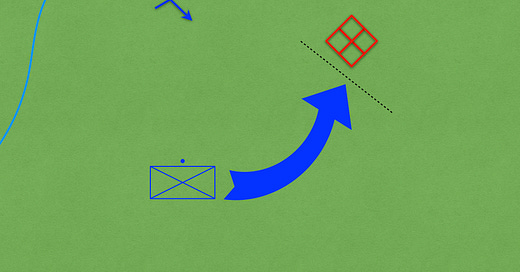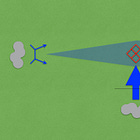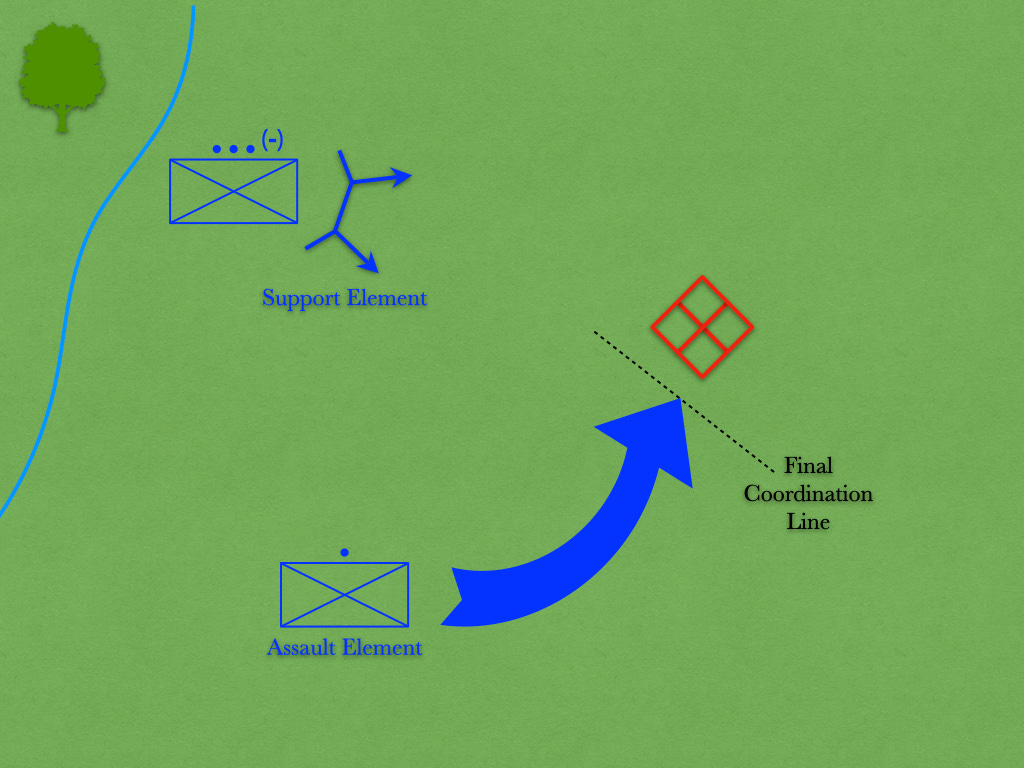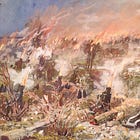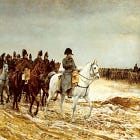With this article, the Tactical Notebook continues the serialization of Three Hundred Assaults. Written by Lieutenant Colonel Brendan McBreen, USMC (Retired), Three Hundred Assaults explores the results of an ambitious program of simulations, each of which depicted an assault conducted by a Marine rifle squad. The first three posts in this series can be found by means of the following links.
3. 300 Assaults
Using a computer simulation, we constructed an infantry platoon attack against an enemy position on a hill. The final step of this attack was the assault, where one squad of the attacking platoon assaulted up and cleared the remaining enemy on the objective. Over a period of four months, we repeated this assault 300 times—against different types of enemies, defending different fighting positions, with different weapons, and from different distances.
a. The simulated attack was a platoon daylight dismounted flanking attack. The concept of operations (CONOPS) is shown in Figure 1. A standard Marine infantry platoon of approximately 44 Marines, reinforced with three 60mm mortars and two medium machineguns, attacked an enemy position on a hill occupied by 12 to 15 enemy soldiers. No artillery, air, or vehicles supported the attack.
The terrain was rough terraced hills, generally open, with intermittent trees, scrub grass, and vegetation that provided concealment and some cover. See Figure 2. The uneven folds in the hills and changes in elevation provided intermittent defilade for the assault element and often blocked visibility of the enemy. From some unobstructed positions, however, the enemy could see the assault element moving 400 meters away.
The platoon attack order in Appendix A dictated the sequence of events. From the line of departure in the woods, the platoon crossed a creek and moved across low ground to the cover and concealment of a road embankment. Protected by the security element, the support element—with attached mortars and machineguns—established a support by fire (SBF) position. After sighting enemy positions, deploying weapons, and assigning targets and sectors, the support element opened fire.
Figure 1. The CONOPS for an infantry platoon attack.
A massive volume of fire, from the majority of the platoon, overwhelmed the enemy. Mortar rounds exploded on the objective, machineguns destroyed visible positions and tore up the ground, and automatic rifle and 40mm grenade fire suppressed enemy soldiers.
Figure 2. View of the objective from the assault position behind the road embankment.
The assault element—a rifle squad of 13 Marines—had moved south to the assault position. On the platoon commander’s order—“Assault!”—the squad crossed the road and moved forward toward the objective. On top of the hill, three or four remaining enemy soldiers turned toward the new threat on their flank.
b. The computer simulation we used was the current Combat Mission (CMSF2) v2.03, produced by Battlefront.com. This simulation models small-unit ground combat with extreme realism and tremendous detail, down to individual weapons and soldiers. Terrain—which dictates most of ground combat—is precisely modelled: dips and folds in the ground, visibility, lines of sight, concealment, and protective cover. Weapons are accurately modelled: ranges, trajectories, effects, ammunition expenditure, and reload and redeployment times.
Soldier skills are modelled: marksmanship, speed of movement, battlefield awareness, and response times. Human factors are modelled: fatigue, morale, leadership, and experience. Exhausted soldiers react slowly. Soldiers with low morale and poor leadership often panic and run. The fidelity of the simulation makes it an ideal tool to simulate an infantry attack—especially multiple repetitions of the same infantry attack—against an unpredictable enemy.
The simulation models artillery and mortar fire, but our mortars ceased fire before the assault element advanced. Our single simulated enemy position had no reinforcements, no indirect fire, and no additional overwatch positions from which to provide mutual support. Friendly fire, casualty evacuation, night combat, night vision optics, and drones were NOT simulated. For each of our assaults, a human made the decisions for both sides. No computer artificial intelligence was used.
c. We established six scenarios, each representing a different type of enemy of increasing abilities:
Scenario A. Assaults against three enemy conscripts with automatic rifles lying in the open grass and facing the assault element.
Scenario B. Assaults against three enemy conscripts with automatic rifles manning a fighting hole and facing the assault element.
Scenario C. Assaults against three enemy conscripts manning a machinegun in a fighting hole and facing the assault element.
Scenario D. Assaults against three well-trained enemy soldiers with automatic rifles lying in the open grass and facing the assault element.
Scenario E. Assaults against four well-trained enemy soldiers with automatic rifles manning a fighting hole and facing the assault element.
Scenario F. Assaults against three well-trained enemy soldiers manning a machinegun in a fighting hole and facing the assault element.
For each scenario, we executed ten assaults from 400 meters, ten assaults from 200 meters, ten assaults from 100 meters, and ten assaults from 50 meters. The enemy changed positions and tactics after each assault. For some scenarios, additional assaults were conducted.
Enemy parameters. The conscript enemy used for scenarios A, B, and C had low morale and poor leadership. Soldier skills, especially marksmanship and camouflage, were poor. The well-trained enemy used for scenarios D, E, and F was comparable to a modern Marine unit, with high levels of weapons skills, leadership, and morale.
Friendly parameters. The assault element was a squad of 13 Marines, armed with M16 rifles, M249 SAW, M203 40mm grenades launchers, optics, and full ammunition. They were well-rested and well-trained, with excellent morale, good communications, and good leadership.
For Further Reading:


